- Details
- Hits: 1209
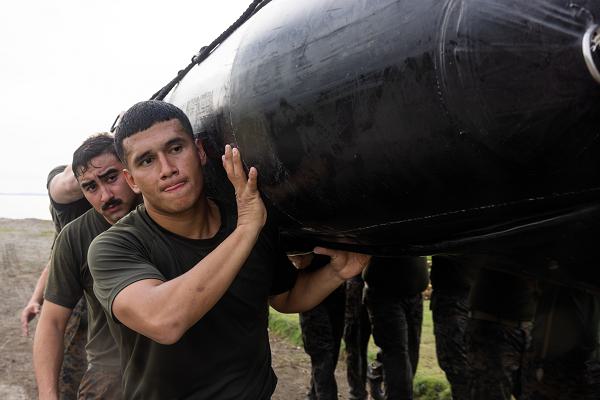
Apartado, Colombia. (August 13, 2024): When the U.S. Marines want to train with experts at riverine warfare, they turn to Columbia with its vast jungles and fast-moving rivers. In this photo by Corporal Trystan Taft, Marines with Littoral Craft Company Charlie, 4th Assault Amphibian Battalion, 4th Marine Division, carry a boat during the swim qualification portion of the Colombian Fluvial Operations Course. The Course consists of multiple training exercises including swim qualification, classroom lectures, weapons handling and maintenance, and littoral craft maneuvers. The course is divided into three-week intervals with the first week comprised of classroom instruction to familiarize Marines with the different Columbian Littoral crafts.
Columbia, with its half a million square miles of forests, grasslands, mountains, and jungles, is an ideal training venue for the Marines. The town of "Apartadó", meaning "river of plantains" in the local Indian language, is located near the Atlantic Ocean in the Gulf of Urabá. Its economy is based on bananas, plantain, corn, cassava, cocoa, wood, and livestock. The mean maximum temperature is a scorching eighty-six °F and the relative humidity is above 80% year-round.
- Details
- Hits: 1341
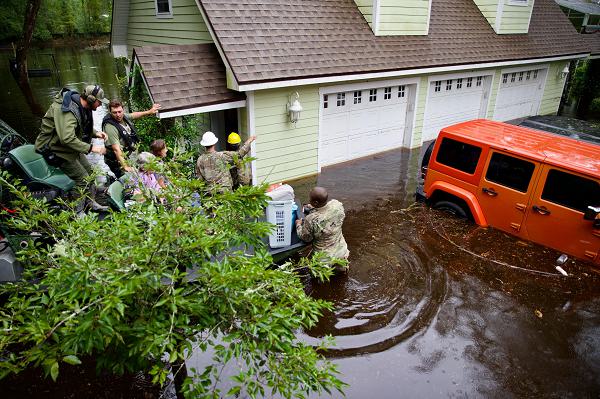
Live Oak, Florida. (August 14, 2024): If you are a National Guard Soldier serving in Florida, you know things are going to get dicey in the next few months. With the recent arrival of Hurricane Debby, the Florida National Guard has deployed across the state to support local communities and to help citizens in trouble. In this photo by Sergeant First Class Trinity Bierley, Soldiers from the 868th Engineer Company conduct a high-water rescue operation following flooding from Hurricane Debby. Florida’s Governor activated some 3,000 National Guard Soldiers on August 1st to prepare for the storm while declaring a state of emergency for sixty-one Florida Counties.
The deployment began with Soldiers from the 927th CSSB setting up shop in the State’s Logistics Resource Center, a facility that stores water, food, and other emergency supplies for distribution after the storm makes landfall. Additionally, the Guard’s 1st Battalion, 111th Aviation Regiment, prepared Black Hawk helicopters at the Tallahassee International Airport for support operations across the state. Other units, such as the 1-265th Air Defense Artillery Battalion, conducted route clearing and debris removal on city streets and supported an assisted living facility with its elderly and frail residents.
The Florida National Guard traces its heritage to 1565, the year the Spanish founders of St. Augustine organized their first company of citizen-Soldiers. Florida’s militia has defended local communities for over 440 years. The current Florida Army National Guard was established in 1907 and boasts almost 12,000 members including 450 state employees and nine hundred full-time Federal personnel. The Guard is made up of both Army and Air Force units and is headquartered at St. Augustine on the east coast.
The Army component includes the 53rd Infantry Brigade Combat Team, 50th Regional Support Group, the 83rd Troop Command, and the 164th Air Defense Artillery Brigade. The Guard also runs Camp Blanding, a Joint Training Center located outside of Jacksonville. The Air component includes the 125th Fighter Wing and the 101st Air and Space Operations Group.
- Details
- Hits: 941
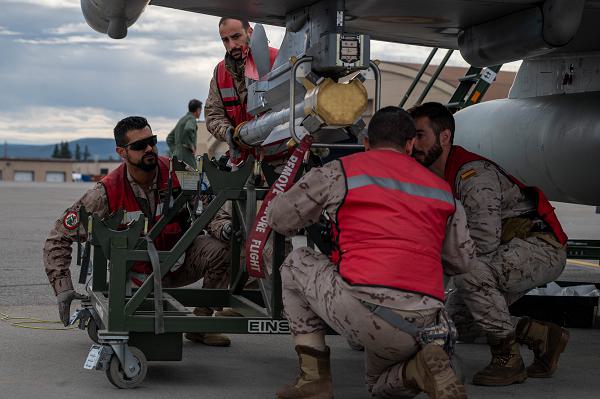
Eielson Air Force Base, Alaska. (August 12, 2024): In this photo by Airman 1st Class Jarrett Smith, Spanish Air and Space Force Soldiers from the 14th Wing load simulated weaponry onto a Spanish Air Force Eurofighter Typhoon during exercise Arctic Defender. The maneuvers are part of a months-long deployment in the Indo-Pacific involving the U.S., Germany, France, and Spain. Over 500 personnel from the U.S., German, French, Spanish and Canadian air forces as well as the U.S. Marine Corps participated in the exercises held at Eielson Air Force Base.
This deployment stretches across the Indo-Pacific region, including Japan, Australia, New Zealand, Malaysia, and India. The French, German and Spanish Air Forces contributed forty-eight aircraft including twelve German Tornados, eight German and four Spanish Eurofighters, four French Rafales jets, four German H145M light helicopters, and four German refueling aircraft. For the Spanish, this is the first deployment of this kind in recent history. In fact, this is being considered as the most ambitious project of Spain since the Atlantic crossing of pioneering Spanish aviators in the 1920s. A major milestone was the flight of Spanish A400M transport aircraft over the North Pole to Alaska.
- Details
- Hits: 1678
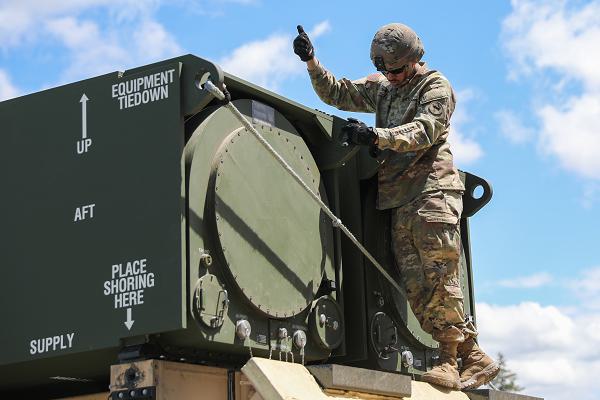
Joint Base Lewis-McChord, Washington. (August 8, 2024): America’s military has debuted a hypersonic weapon that is truly stunning. In this photo by Captain Ryan DeBooy, a Soldier assigned to Bravo Battery, 5th Battalion, 3rd Field Artillery (Long Range Fires Battalion), 1st Multi-Domain Task Force, operates the transporter/erector launcher for the Army’s new Long Range Hypersonic Weapon.
Known as Dark Eagle, this truck launched system can fire a missile that travels well over 3,800 mph and can hit a target at a range of 1,725 miles. The projectile reaches the limit of the earth’s atmosphere, above air, and missile defense range, before plunging to strike the enemy before they have time to react.
The Army introduced their new weapon during Exercise Resolute Hunter, a Navy led series of field problems that integrated hypersonic weapons into America’s arsenal for the first time. Each battery includes four launchers with two missiles each, a battery command unit, and an operations support vehicle.
- Details
- Hits: 2148
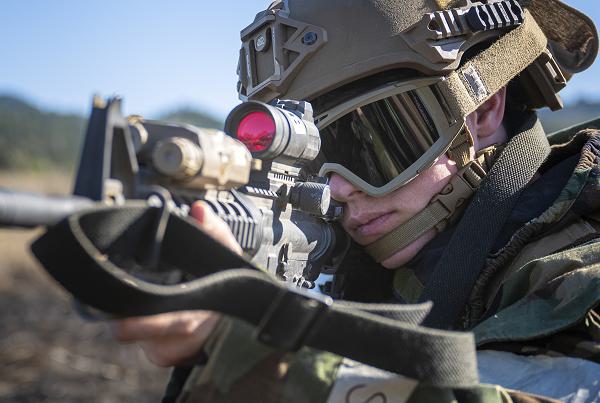
Fort Hunter-Liggett, California. (August 10, 2024): The U.S. military has adopted a new generation of infantry rifle that owes a great deal to its predecessor, the reliable M-16A1. In this photo by Staff Sergeant Scott Warner, Staff Sergeant Miles Winford, an 821st Contingency Response Squadron weather technician, aims his M-4 carbine during a training exercise. The M-4 is a shorter and lighter variant of the M16 rifle with remarkably similar operating mechanisms that share roughly 80 percent of the same parts. Developed in the 1980s, the M4's design was based on shortening the barrel length from 20 to 14.5 inches without compromising long-range accuracy.
Some of the upgraded features of the M-4 include a faster firing action, a setting for a three-shot pattern, and additional accessories like flash suppressors, silencers, and grenade launchers. It also comes with a collapsible stock making the weapon better suited for an urban environment. It holds thirty bullets, and it is somewhat easier to switch out magazines than the M16. The shortened barrel length makes the rifle lighter than the M-16 (7 v. 9 pounds) although accessories can practically double that weight.
Finally, the M-4 has a much longer service life than other assault rifles and is reasonably priced at $1,250 per unit. By drawing upon the lessons learned from the M-16, America’s military now has a much-improved basic infantry weapon.
- Details
- Hits: 1275
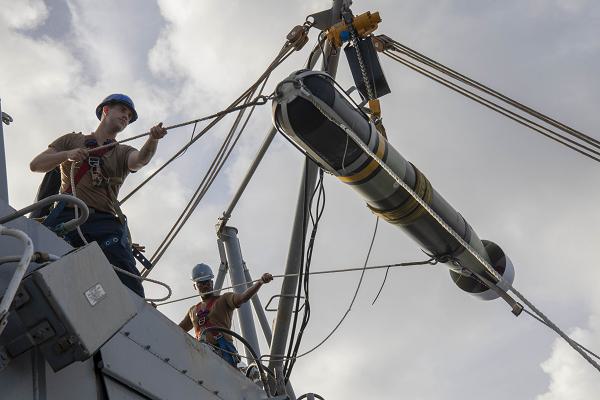
Pacific Ocean. (August 7, 30, 2024): The Navy has managed to combine the best of previous missile technologies into a weapon that plays multiple roles in America’s defense. In this photo by Seaman Joey Sitter, Sonar Technician (Surface) 3rd Class Josiah Kirchofer, left, from Dallas, and Sonar Technician (Surface) 2nd Class Pierre Ducasse, from Los Angeles, hoist a Mark 54 lightweight torpedo onto the deck of the Arleigh Burke-class guided-missile destroyer USS Spruance.
Previous torpedo designs were either too expensive for routine use or performed poorly in shallow water, something the Navy anticipates will be a major need in the next conflict. The Mark 54 combines the homing portion and propulsion sections of previous missiles to create a lightweight hybrid which is now the standard for anti-submarine warfare.
Developed by Raytheon Integrated Defense Systems, The Mark 54 uses existing torpedo hardware and software plus state-of-the-art digital signal-processing technology. It incorporates an advanced guidance and control system and tactical software to improve torpedo performance.


